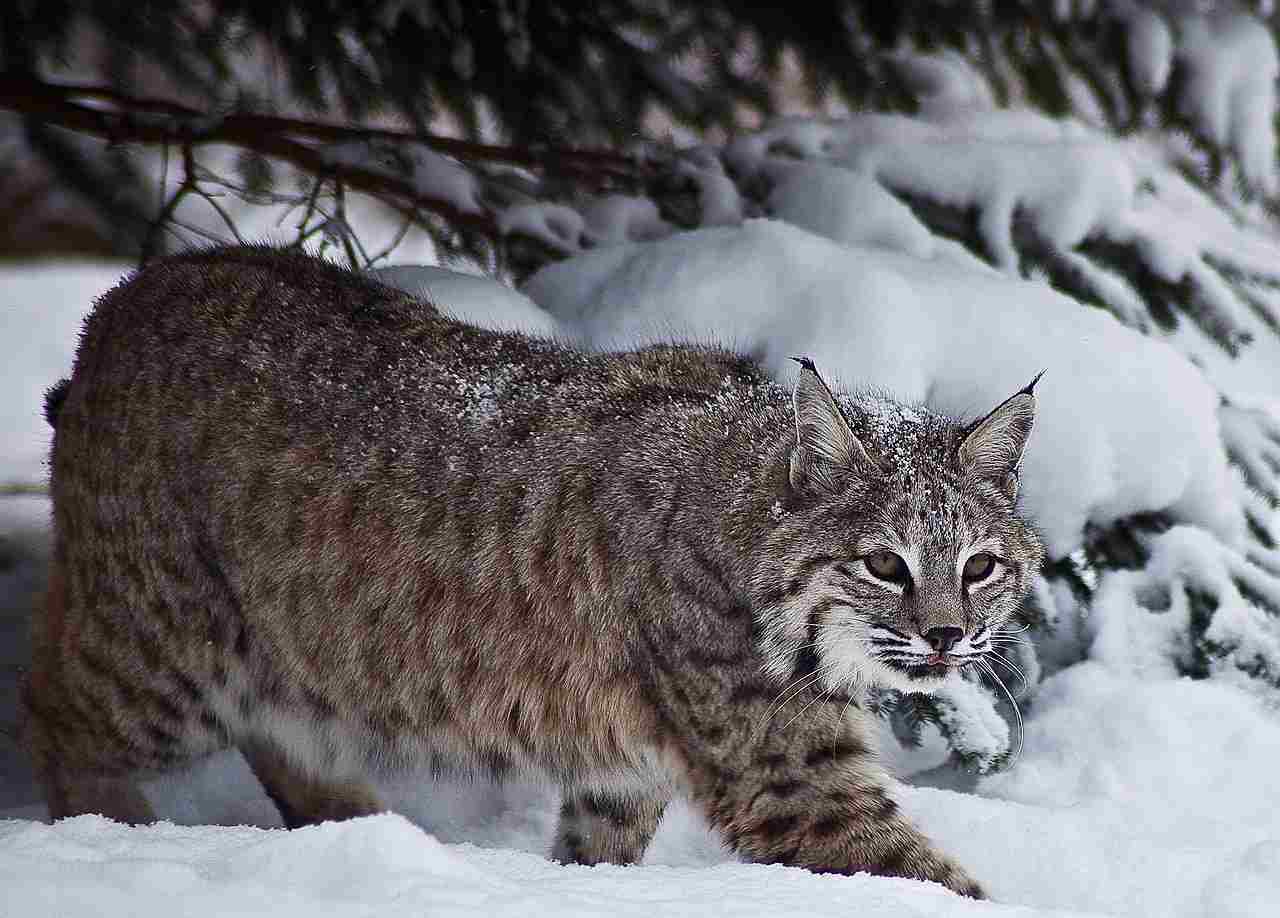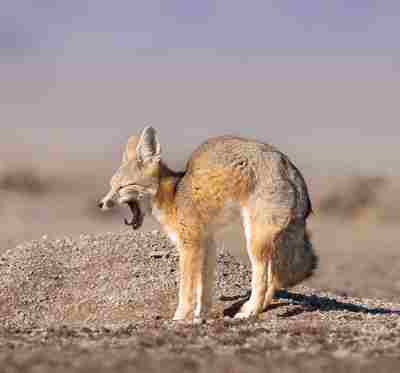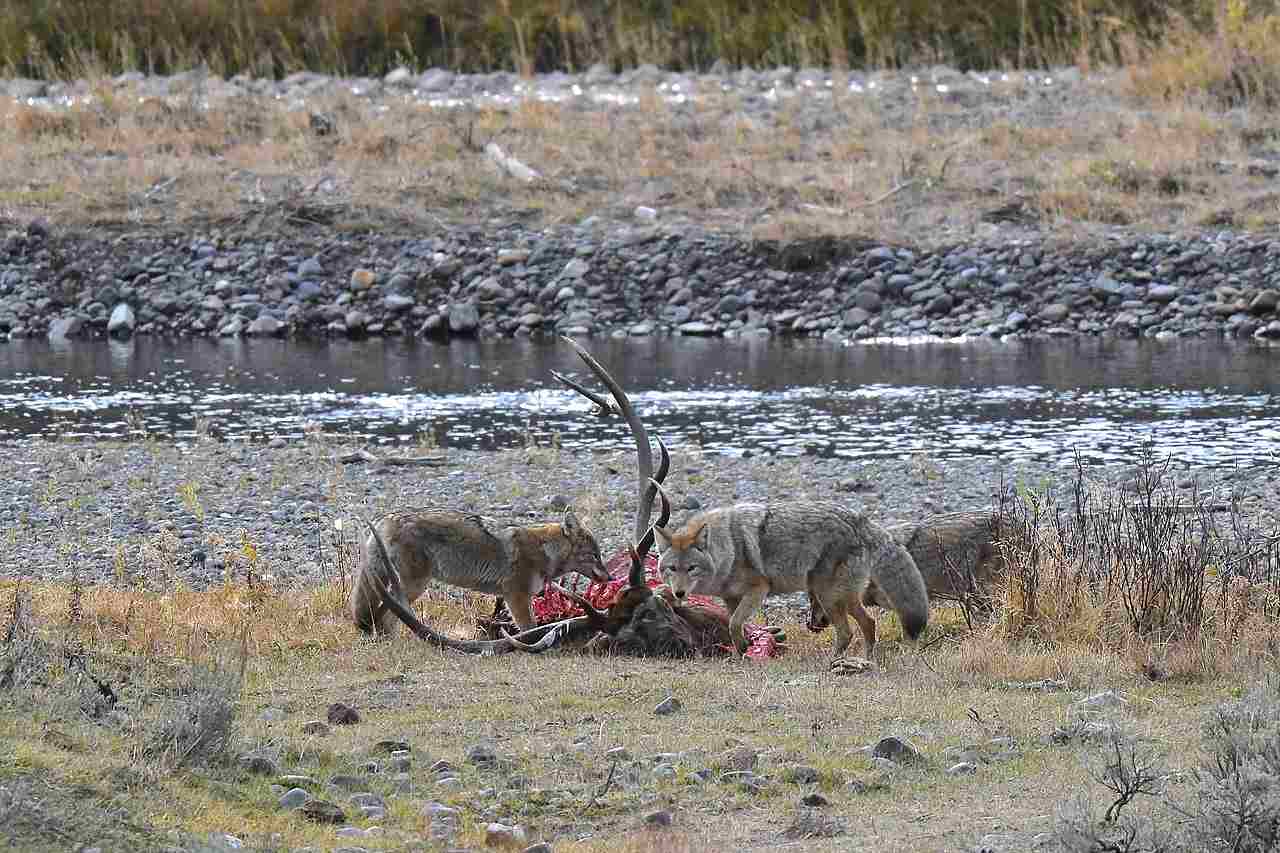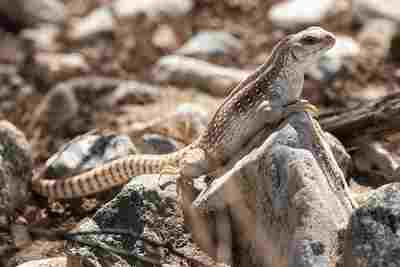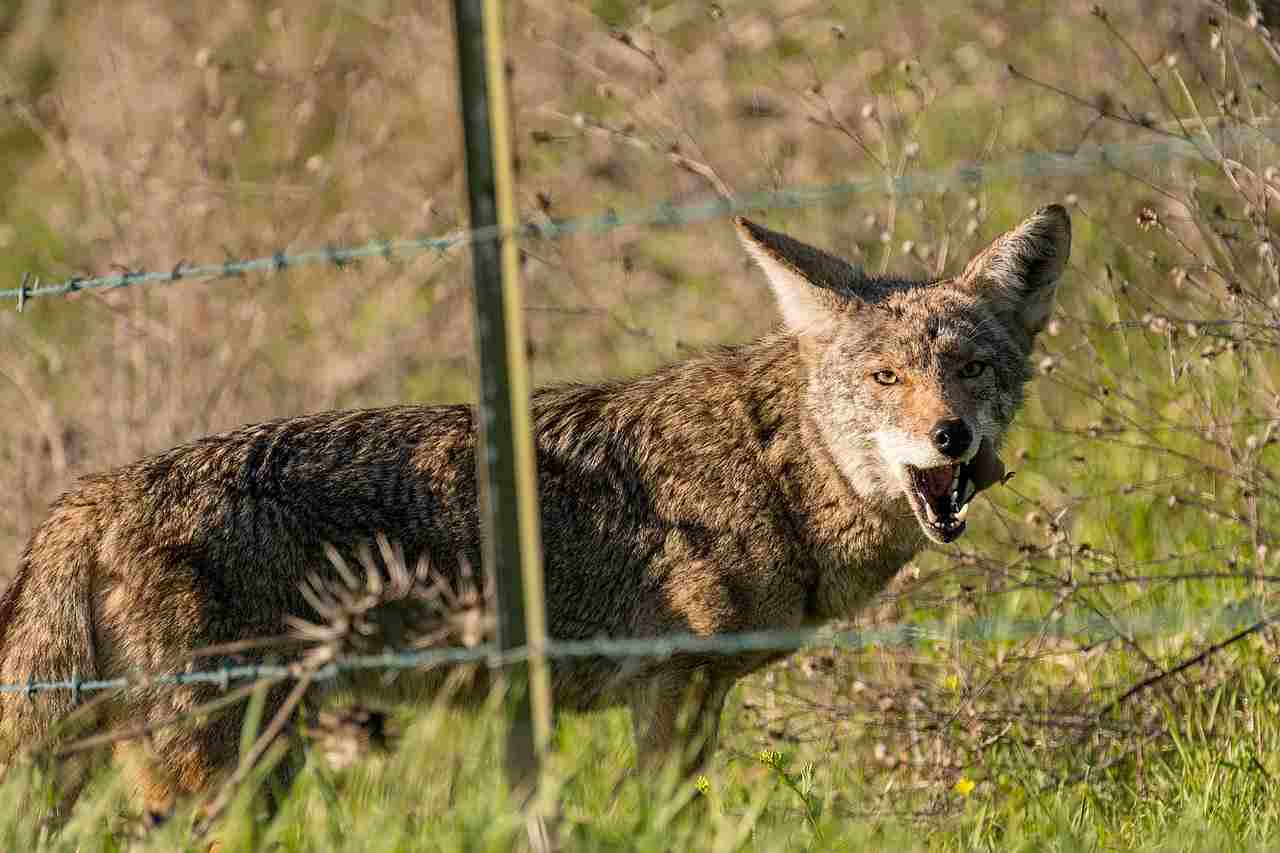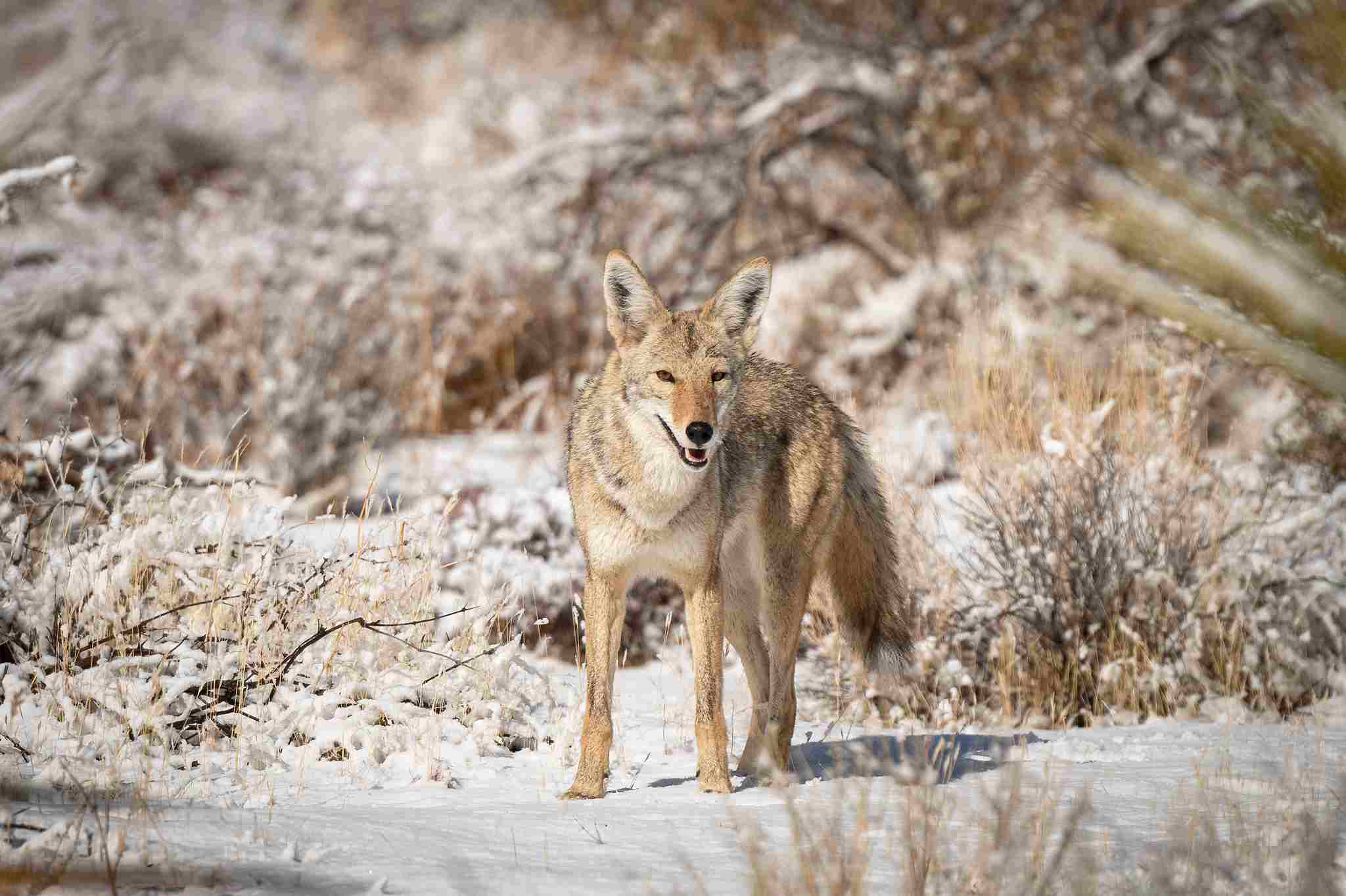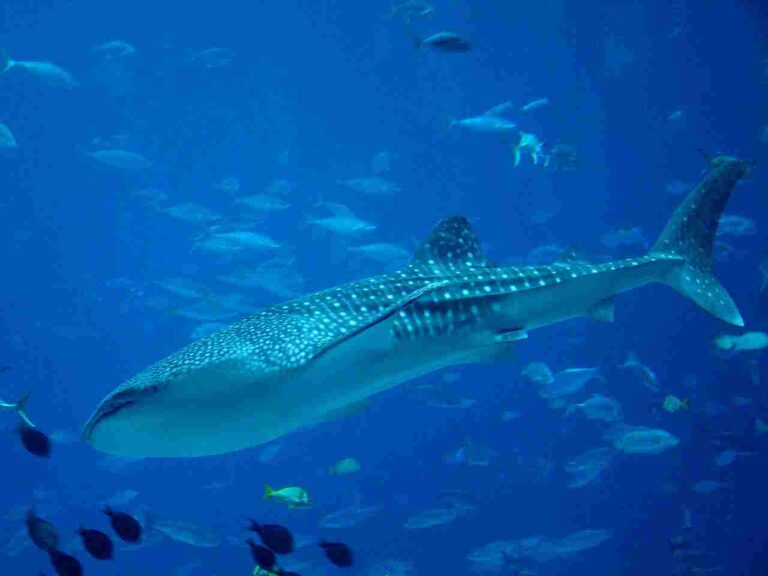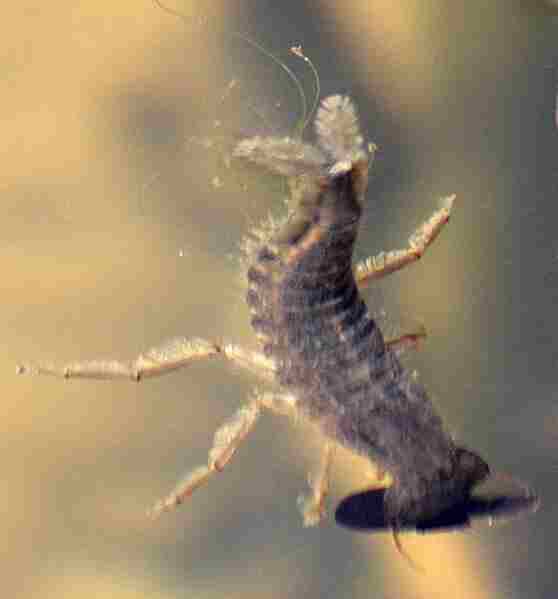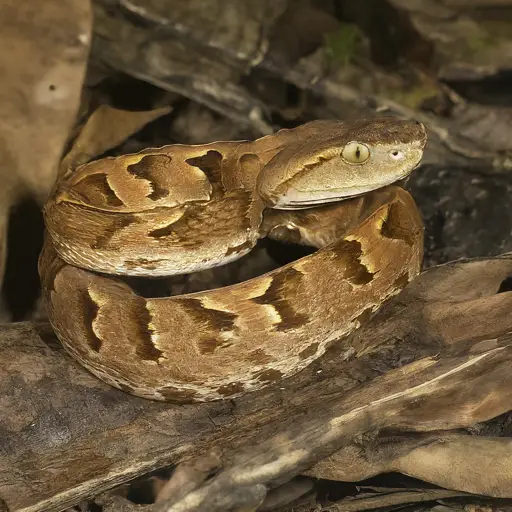23+ Dangerous Animals In Death Valley And Their Characteristics
Examples of dangerous animals in Death Valley include the Western Diamondback Rattlesnake, known for its hemotoxic venom and diamond-shaped patterns; the Mojave Green Rattlesnake, with potent neurotoxic and hemotoxic venom; and the Black Widow Spider, which has neurotoxic venom and is recognized by its black body and red hourglass marking. The Mountain Lion is a large predator capable of attacking when provoked, and the Tarantula Hawk Wasp is infamous for its painful sting. Coyotes and bobcats can be aggressive when threatened, while the Great Horned Owl and the Red-tailed Hawk can attack if their nests are disturbed. Desert Bighorn Sheep can be dangerous when protecting their territory, and the Arizona Bark Scorpion has a potentially lethal sting. It is essential to exercise caution and respect these animals’ habitats to avoid dangerous encounters.
1. Western Diamondback Rattlesnake
The Western Diamondback Rattlesnake (Crotalus atrox) is one of the most notorious and venomous snakes found in Death Valley. Recognized by its distinctive diamond-shaped patterns along its back and the characteristic rattle at the end of its tail, this rattlesnake can reach lengths of up to 7 feet, making it one of the largest rattlesnakes in North America. Its venom is a potent hemotoxin, capable of causing significant tissue damage, bleeding, and, in severe cases, death. Found in a range of habitats, from desert scrub to rocky terrain, the Western Diamondback Rattlesnake is typically reclusive, preferring to avoid human contact. However, when threatened or startled, it will coil and rattle as a warning before striking. Encounters with this snake should be approached with caution, and maintaining a safe distance is recommended. If bitten, immediate medical attention is crucial to mitigate the effects of the venom.
2. Mojave Green Rattlesnake
The Mojave Green Rattlesnake (Crotalus scutulatus) is one of the most venomous rattlesnakes in Death Valley, renowned for its potent neurotoxic and hemotoxic venom. This combination can cause severe neurological symptoms such as paralysis and respiratory failure, along with intense pain and tissue damage. With a light green hue that helps it blend into desert scrub, this rattlesnake is typically found in arid environments and is known for its aggressive demeanor when threatened. It will coil and rattle as a warning, but if these signals are ignored, it will strike quickly. Due to the severity of its venom, immediate medical attention is critical in the event of a bite.
3. Sidewinder Rattlesnake
The Sidewinder Rattlesnake (Crotalus cerastes) is unique for its distinctive sideways movement, allowing it to traverse sandy desert landscapes with agility and speed. Found throughout Death Valley, this smaller rattlesnake has a subtle, sandy coloration that helps it blend into its environment. While its venom is less potent than some other rattlesnakes, it can still cause painful bites and tissue damage. The sidewinder is generally reclusive and prefers to avoid confrontation, but will rattle and strike if it feels threatened. Due to its natural camouflage, it’s essential to watch where you step to avoid accidental encounters.
4. Panamint Rattlesnake
The Panamint Rattlesnake (Crotalus stephensi) is a relatively large species of rattlesnake found in the rocky areas and higher elevations of Death Valley. With a coloration that varies from gray to tan, it blends seamlessly into the rocky terrain it inhabits. Known for its powerful rattle and striking ability, the Panamint Rattlesnake is highly venomous and can deliver a painful and potentially deadly bite. While it generally avoids human contact, it will defend itself aggressively if cornered or threatened. It is crucial to stay on marked trails and be vigilant in areas where it might reside. Immediate medical treatment is necessary in case of a bite.
5. Speckled Rattlesnake
The Speckled Rattlesnake (Crotalus mitchellii) is one of the more visually striking rattlesnakes in Death Valley, with a speckled pattern that provides excellent camouflage against rocky and sandy backgrounds. It has a medium-sized body and a powerful rattle, which it uses as a warning to potential threats. This rattlesnake’s venom is hemotoxic, causing pain, swelling, and tissue damage. Although it is generally not aggressive, it will strike if provoked or surprised. Encounters are more likely in rocky areas and at higher elevations, so hikers and climbers should be cautious and attentive to their surroundings. Medical attention should be sought immediately if bitten.
6. Coyote
The Coyote (Canis latrans) is a highly adaptable predator found throughout Death Valley. While generally wary of humans, coyotes can be dangerous if they become habituated to human presence or if they feel threatened. They are known to scavenge for food and might approach campsites or picnic areas in search of scraps. Coyotes are opportunistic and can be aggressive when defending their territory or hunting for food. It is advisable to secure food and trash to avoid attracting them, and to never approach or feed coyotes. If they become aggressive, standing tall and making loud noises can help scare them away. Although coyote attacks on humans are rare, they can pose a threat to pets, so keeping pets leashed and supervised is recommended.
7. Mountain Lion

The Mountain Lion (Puma concolor), also known as the cougar, is a powerful and stealthy predator that can be found in Death Valley’s more remote areas. With a sleek body and a long tail, the mountain lion is capable of leaping great distances and stalking prey with incredible stealth. Though attacks on humans are rare, mountain lions can be dangerous if they perceive a threat to their territory or are desperate for food. If you encounter a mountain lion, it’s crucial to maintain eye contact, make yourself appear larger by raising your arms or jacket, and back away slowly. Running can trigger a predatory response, so it’s important to stay calm and assertive. If a mountain lion attacks, fight back aggressively to protect yourself.
8. Black Widow Spider
The Black Widow Spider (Latrodectus mactans) is a venomous spider known for its distinctive black body and red hourglass marking on the abdomen. Found in Death Valley, black widows prefer dark, undisturbed places such as woodpiles, rock crevices, and under debris. Their venom is a potent neurotoxin, causing muscle cramps, pain, and, in severe cases, respiratory issues. Although black widow bites are rarely fatal to humans, they can be extremely painful and require medical attention. To avoid encounters, be cautious when reaching into dark areas and wear gloves when handling outdoor materials. If bitten, seek medical help promptly, as antivenom may be required for severe reactions.
9. Brown Recluse Spider
The Brown Recluse Spider (Loxosceles reclusa) is a venomous spider known for its shy nature and violin-shaped marking on its back. Though not native to Death Valley, it has been found in surrounding regions. This spider prefers dark, undisturbed areas like closets and woodpiles. Its venom contains a cytotoxin that can cause necrosis, leading to severe tissue damage around the bite site. While bites are relatively rare, they can lead to significant medical complications if not treated promptly. If you suspect a brown recluse bite, seek medical attention immediately, as early treatment can minimize tissue damage and complications. To avoid encounters, inspect clothing, bedding, and shoes before use, especially in areas where the spider is known to reside.
10. Tarantula Hawk Wasp
The Tarantula Hawk Wasp (Pepsis spp.) is one of the largest wasps found in Death Valley, notable for its vibrant orange wings and metallic blue-black body. It is infamous for its excruciating sting, which is considered one of the most painful insect stings in the world. Despite its fierce reputation, the tarantula hawk is generally not aggressive toward humans and uses its sting primarily to paralyze tarantulas, its primary prey. If threatened or handled, however, it will sting as a defense mechanism. To avoid encounters, it’s best to give this wasp a wide berth and avoid swatting or provoking it. If stung, the pain can be intense but typically subsides within a few hours. Keep the affected area clean, and seek medical attention if you experience severe allergic reactions.
11. Scorpion (Arizona Bark Scorpion)
The Arizona Bark Scorpion (Centruroides sculpturatus) is the most venomous scorpion in North America, found in Death Valley and surrounding desert areas. Recognized by its slender body and tail with a distinctive stinger, this scorpion can deliver a venomous sting that causes intense pain, numbness, and, in some cases, severe reactions like respiratory distress. It is nocturnal and prefers hiding in dark crevices or under rocks, which makes it easy to encounter by accident. To avoid stings, be cautious when handling outdoor materials and always wear shoes when walking in dark areas at night. If stung, seek medical attention promptly, as antivenom may be required for severe reactions or in children and the elderly.
12. Gila Monster
The Gila Monster (Heloderma suspectum) is one of the few venomous lizards found in Death Valley and the surrounding desert regions. Recognized by its vibrant orange and black bead-like scales, this slow-moving lizard can deliver a potent venom through grooves in its teeth. While not typically aggressive, the Gila Monster will bite if provoked or handled, and its bite can cause intense pain, swelling, and other serious symptoms. This lizard is protected under law due to its declining population, so it is essential to observe from a distance and not attempt to handle or disturb it. If bitten, seek immediate medical attention, as the venom can cause significant health complications.
13. Western Desert Tarantula
The Western Desert Tarantula (Aphonopelma spp.) is a large, hairy spider found in Death Valley, often residing in burrows or under rocks. Although it may appear intimidating due to its size, the western desert tarantula is generally docile and rarely aggressive toward humans. Its bite, though painful, is not venomous to the extent that it poses a significant threat to humans. These spiders are most active during mating season, typically in late summer and early autumn. To avoid surprising them, watch where you step, and avoid disturbing their burrows. If bitten, the pain usually subsides within a few hours, and standard wound care is generally sufficient. However, if you have an allergic reaction or the bite site becomes infected, seek medical attention.
14. Great Basin Rattlesnake
The Great Basin Rattlesnake (Crotalus lutosus) is a highly adaptable rattlesnake found in Death Valley and surrounding regions. Known for its varied coloration, ranging from brown to gray, and its powerful rattle, this rattlesnake can be found in a variety of habitats, from rocky outcrops to grasslands. It is generally shy and avoids human contact, but will rattle and strike if it feels threatened or cornered. Its venom is hemotoxic, causing pain, swelling, and tissue damage, and can be dangerous if not treated promptly. To avoid encounters, stay on marked trails and be aware of your surroundings, especially in rocky areas. If bitten, seek immediate medical attention for proper evaluation and treatment.
15. Kit Fox
The Kit Fox (Vulpes macrotis) is a small, nocturnal fox species found in Death Valley. While not typically aggressive, kit foxes can carry diseases such as rabies and can become dangerous if they feel threatened or cornered. These foxes are agile and elusive, preferring to avoid human contact, but they might be attracted to food or trash left unsecured in campgrounds or picnic areas. To minimize the risk of encountering a kit fox, ensure food and trash are properly secured and do not attempt to approach or feed them. If you do encounter a kit fox, maintain a safe distance and do not attempt to touch or handle it. If bitten or scratched, seek medical attention to rule out potential diseases and ensure proper wound care.
16. Red-tailed Hawk
The Red-tailed Hawk (Buteo jamaicensis) is a common bird of prey in Death Valley, recognizable by its reddish tail feathers and broad wingspan. Though not typically aggressive toward humans, red-tailed hawks can be dangerous if provoked or if they perceive a threat to their nest or territory. With sharp talons and a powerful beak, these hawks can cause significant injuries if they attack. To avoid conflict, give nesting hawks a wide berth and avoid disturbing them. If you spot a hawk in a tree or on a nest, maintain a safe distance and do not attempt to climb or approach. If attacked, use protective clothing or objects to shield yourself and seek medical attention for any injuries caused by their sharp talons or beak.
17. Bobcat
The Bobcat (Lynx rufus) is a medium-sized wildcat found in Death Valley, known for its tufted ears and short “bobbed” tail. Although typically elusive and preferring to avoid humans, bobcats can be dangerous if they feel threatened or are protecting their territory. They are agile hunters with sharp claws and teeth, capable of inflicting serious injuries if they attack. Encounters with bobcats are rare, but if you come across one, it’s best to maintain a safe distance and avoid direct eye contact. If a bobcat seems aggressive, make yourself appear larger, make loud noises, and back away slowly without turning your back. If attacked, fight back to protect yourself and seek medical attention for any injuries.
18. Desert Bighorn Sheep
Desert Bighorn Sheep (Ovis canadensis nelsoni) are majestic creatures with large, curved horns, found in the rocky terrains of Death Valley. While generally non-aggressive, they can become dangerous if they feel threatened or cornered. Rams, in particular, may show aggression during mating season or when defending their territory. To avoid conflicts, observe bighorn sheep from a distance and never attempt to approach or feed them. If they show signs of aggression, such as lowering their heads or stomping their feet, it’s best to back away slowly. Although attacks are rare, they can cause significant injury with their powerful horns if provoked.
19. Western Burrowing Owl
The Western Burrowing Owl (Athene cunicularia) is a small, ground-dwelling owl found in Death Valley. While generally not dangerous to humans, these owls can become aggressive if their nest is threatened. They are known to nest in abandoned burrows and might attack with their sharp beaks and talons if they feel their territory is at risk. To avoid conflicts, maintain a safe distance from burrows and avoid disturbing them during nesting season. If attacked, protect yourself with clothing or objects and move away from the area. Although attacks are rare, the sharp beak and talons of a burrowing owl can cause injuries that require medical attention.
20. Great Horned Owl
The Great Horned Owl (Bubo virginianus) is one of the largest owls in North America, easily identified by its distinctive ear tufts and powerful build. Found in Death Valley, these owls are skilled predators and can be dangerous if their nest is threatened or if they feel provoked. With strong talons and a sharp beak, they are capable of causing significant injuries. To avoid conflicts, stay clear of known nesting areas and avoid provoking them. If you encounter a great horned owl that seems aggressive, back away slowly and avoid direct eye contact. If attacked, use clothing or other objects to protect yourself, and seek medical attention for any injuries caused by their sharp talons or beak.
21. Turkey Vulture
The Turkey Vulture (Cathartes aura) is a large scavenging bird commonly seen soaring over Death Valley. Though primarily scavengers, turkey vultures can become dangerous if they feel cornered or if their nesting site is threatened. With large beaks and powerful wings, they can cause injuries if provoked. Turkey vultures are generally not aggressive toward humans, but they might defend their nesting sites or carcasses aggressively. To avoid conflicts, observe from a distance and do not attempt to approach or disturb them. If attacked, use clothing or objects to protect yourself, and seek medical attention for any injuries.
22. American Kestrel
The American Kestrel (Falco sparverius) is a small falcon found in Death Valley, known for its vibrant plumage and agile flight. Although generally not aggressive toward humans, kestrels can be dangerous if they feel threatened or if their nest is disturbed. With sharp talons and a pointed beak, they can inflict injuries if they attack. To avoid conflicts, maintain a safe distance from nesting sites and avoid provoking or startling them. If you encounter an aggressive kestrel, use clothing or objects to protect yourself, and back away slowly. If attacked, seek medical attention for any injuries caused by their sharp talons or beak.
23. Badger
The Badger (Taxidea taxus) is a stocky and powerful animal found in Death Valley, known for its strong digging capabilities and sharp claws. Though generally reclusive, badgers can be aggressive if they feel threatened or cornered. They have a robust build and sharp teeth, making them capable of causing significant injuries. To avoid conflicts, keep a safe distance and do not approach their burrows. If a badger shows signs of aggression, such as growling or charging, it’s best to back away slowly and avoid provoking it. If attacked, use clothing or objects to protect yourself, and seek medical attention for any injuries caused by their sharp claws or teeth.
24. Northern Harrier
The Northern Harrier (Circus cyaneus) is a medium-sized bird of prey found in Death Valley, known for its distinctive facial disk and agile flight. While not typically aggressive toward humans, northern harriers can become dangerous if their nest is threatened or if they feel provoked. They are skilled hunters with sharp talons and a pointed beak, capable of causing injuries if they attack. To avoid conflicts, maintain a safe distance from nesting sites and avoid disturbing them. If a northern harrier seems aggressive, back away slowly and avoid direct eye contact. If attacked, use clothing or objects to protect yourself, and seek medical attention for any injuries caused by their sharp talons or beak.
| Animal | Description |
| Western Diamondback Rattlesnake |
Venomous snake with hemotoxic venom, known for its diamond-shaped patterns.
|
| Mojave Green Rattlesnake |
Venomous snake with potent neurotoxic and hemotoxic venom, known for its light green hue.
|
| Sidewinder Rattlesnake |
Unique rattlesnake with a sidewinding movement, often found in sandy areas.
|
| Panamint Rattlesnake |
Large rattlesnake found in rocky areas, with potent hemotoxic venom.
|
| Speckled Rattlesnake |
Rattlesnake with a speckled pattern, found in rocky terrains.
|
| Coyote |
Adaptable predator known for scavenging, can be aggressive when threatened.
|
| Mountain Lion |
Large predator with stealth and strength, dangerous if provoked or threatened.
|
| Black Widow Spider |
Venomous spider with neurotoxic venom, known for its black body and red hourglass marking.
|
| Brown Recluse Spider |
Venomous spider with cytotoxic venom, known for its violin-shaped marking.
|
| Tarantula Hawk Wasp |
Large wasp with a highly painful sting, generally not aggressive unless provoked.
|
| Scorpion (Arizona Bark Scorpion) |
Most venomous scorpion in North America, with a painful and potentially dangerous sting.
|
| Gila Monster |
Venomous lizard with a slow-moving nature, capable of delivering potent venom through a bite.
|
| Western Desert Tarantula |
Large, docile spider, generally not aggressive but can bite if provoked.
|
| Great Basin Rattlesnake |
Rattlesnake with varied coloration, found in diverse habitats, known for its hemotoxic venom.
|
| Kit Fox |
Small, nocturnal fox that can carry diseases, generally not aggressive.
|
| Red-tailed Hawk |
Bird of prey with sharp talons and beak, dangerous if provoked or if nest is threatened.
|
| Bobcat |
Medium-sized wildcat with sharp claws and teeth, can be aggressive when threatened.
|
| Desert Bighorn Sheep |
Non-aggressive but can be dangerous when protecting territory or during mating season.
|
| Western Burrowing Owl |
Small ground-dwelling owl, dangerous if its nest is threatened.
|
| Great Horned Owl |
Large owl with sharp talons and beak, dangerous if its nest is threatened.
|
| Turkey Vulture |
Large scavenging bird, dangerous when cornered or if nesting site is threatened.
|
| American Kestrel |
Small falcon with sharp talons and beak, can be dangerous if its nest is threatened.
|
| Badger |
Stocky animal with strong digging abilities, can be aggressive when cornered.
|
| Northern Harrier |
Medium-sized bird of prey, can be dangerous when its nest is threatened or if provoked.
|
